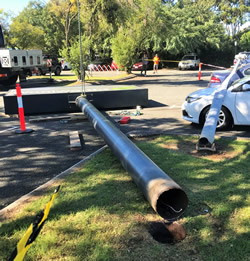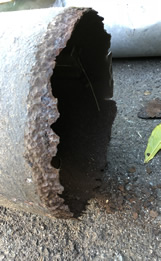Sign collapse
Issued: 19/06/2018
Last Updated: 19/06/2018
Purpose
The purpose of this safety alert is to highlight the risk of collapse of self-supporting signs, and to raise awareness of the need to properly design, maintain and inspect sign structures.
Background
In May 2018, a nine metre high sign structure collapsed and fell on cars in a shopping centre car park. The sign itself was approximately 4.4 metres wide by 1.85 metres high and was supported by a seven metre high hollow steel post. The base of the steel post was embedded in dirt and therefore the foundations could not be seen.
 |  |
| Photograph 1: Collapsed sign. | Photograph 2: Failure area at the base of the support post. |
Contributing factors
The collapse of the sign is currently being investigated. However, it appears that severe corrosion of the main support column at its base was the primary cause. Water ingress and the inability for it to drain away are likely to have contributed to the corrosion.
Action required
Sign design
All sign structures should be designed and installed so that they:
- can safely withstand all anticipated loads (i.e. dead loads and wind loads)
- are designed with adequate durability considering the environment where they are located
- are corrosion resistant and preferably don't have internal cavities where moisture can accumulate.
If it is possible for water to enter the support structure, a system should be provided to ensure water can be drained to minimise the likelihood of internal corrosion. It should be noted that it is often possible for water to enter internal cavities by capillary action.
Where practicable, the design should allow for access to carry out internal inspections (e.g. an inspection hatch) or an alternative method implemented that allows for corrosion monitoring (e.g. a non-destructive test method such as ultrasonic testing).
Sign support posts should not be placed directly in the ground but should be attached to foundations that are corrosion resistant (e.g. a post base plate bolted to a concrete pad above ground level).
Sign inspection and maintenance
Inspection of the sign and its support structure should be carried out by a competent person at periodic intervals and following severe weather events.
Inspection intervals should be determined by considering the:
- structure design
- environmental factors
- rate of degradation of the sign structure.
All critical parts of the sign should be inspected for corrosion, wear and other damage. Critical parts include those parts that could contribute to the risk of collapse or to parts of the sign detaching due to the effects of gravity or wind. Where the sign structure includes internal cavities, an effective method to inspect for internal corrosion should be implemented.
If an inspection uncovers defects with the sign and/or its supporting structure, obtain written advice of a suitably qualified Registered Professional Engineer of Queensland.
PCBU duties
In addition to a structure owner being a PCBU with duties, property managers also have PCBU duties relating to signs.
It is important that PCBUs with duties consult with one another to determine which will coordinate inspection and maintenance of the sign and its supporting structure.
Further information
Further information can be obtained from the following: